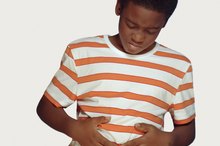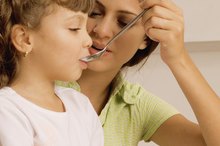Stomach Pain After Eating in a Child
If your child experiences stomach pain after eating, it could indicate one of many sickness or indigestion problems. Because your child’s immune system is less developed, he is especially at risk for food poisoning and other illnesses 3. It is important to recognize the causes of abdominal pain after eating and understand how you can help your child to feel better 12.
Causes
A generalized pain in your child’s stomach after eating may indicate indigestion or gas. If she is constipated, she may experience cramping after eating. Abdominal pain can also be caused by heartburn or lactose intolerance 12. If your child has just tried a high allergenic food for the first time, such as nuts, berries, wheat, eggs or fish, her abdominal pain may be caused by a food allergy 12. Food poisoning, caused by harmful bacteria, can cause your child to experience abdominal pain, vomiting or diarrhea one to eight hours after eating 123.
- A generalized pain in your child’s stomach after eating may indicate indigestion or gas.
Diagnosis
Decreased Appetite & Stomach Pain in Children
Learn More
If you are concerned about your child’s stomach pain, call his doctor. His doctor may want to see him in order to determine the cause of the stomach pain and the best way to help him feel better. The doctor may ask you questions about your child’s activity and recent consumption of food and beverages. Let your child’s doctor know if he is having any other symptoms. A physical exam may help the doctor to determine the cause of the stomach pain, and further testing for internal problems or allergies may be necessary.
- If you are concerned about your child’s stomach pain, call his doctor.
- The doctor may ask you questions about your child’s activity and recent consumption of food and beverages.
Treatment
Many stomach ailments require a waiting period for your child to feel better. Food poisoning can last anywhere from one to 10 days 3. If your child has been vomiting, avoid giving her solid food for a few hours. When she is ready to eat solid foods, start with mild items such as applesauce or crackers. If your child is having gas or constipation pains, AskDrSears.com recommends giving her a warm bath or placing warm towels on her stomach 2. You can also gently rub her stomach, which can help move gas pains along. If she is experiencing heartburn or indigestion, ask her doctor about giving her antacids.
- Many stomach ailments require a waiting period for your child to feel better.
Recommendations
Can Gas Give an Infant a Fever?
Learn More
To help prevent your child from experiencing stomach pain after eating, be sure to practice food safety and proper kitchen hygiene. Wash your hands before and after preparing meals, and keep cutting boards and other cooking supplies clean. This will help prevent your child from getting food poisoning 3. If his pain is related to constipation, encourage him to eat foods with a lot of fiber, such as fruits and vegetables. If he frequently experiences heartburn and indigestion, avoid potentially aggravating foods like citrus, tomato products, fattening foods or fried or greasy products.
- To help prevent your child from experiencing stomach pain after eating, be sure to practice food safety and proper kitchen hygiene.
Warnings
If your child’s stomach pain is severe, in one spot or prevents her from walking, call her doctor right away. It could indicate a problem such as appendicitis. You should also contact her doctor if she is vomiting blood, has a temperature, has diarrhea for more than two days or vomits for more than 12 hours.
Related Articles
References
- Medline Plus: Abdominal Pain
- AskDrSears.com: Abdominal Pain
- MayoClinic.com: Food Poisoning
- Kids Health: Stomachaches
- Centers for Disease Control and Prevention. (2019). Foodborne Illnesses and Germs.
- Cdc.gov. x. Burden of Foodborne Illness: Findings | Estimates of Foodborne Illness | CDC. Published 2018
- Cdc.gov.. Burden of Foodborne Illness: Findings | Estimates of Foodborne Illness | CDC. Published April 2019.
- Papaconstantinou HT, Thomas JS. Bacterial colitis. Clin Colon Rectal Surg. 2007;20(1):18–27. doi:10.1055/s-2007-970196
- Sobel J. Botulism. Clin Infect Dis. 2005;41(8):1167-73. doi:10.1086/444507
- Food Poisoning Symptoms. Centers for Disease Control and Prevention. Published October 11, 2019.
- Bintsis T. Foodborne pathogens. AIMS Microbiol. 2017;3(3):529–563. Published 2017 Jun 29. doi:10.3934/microbiol.2017.3.529
- Chris A. Norwalk-like viruses: when the runs can slow you down [published correction appears in CMAJ. 2003 Feb 18;168(4):400]. CMAJ. 2003;168(1):64–65. PMID: 12515788
- Pinchuk IV, Beswick EJ, Reyes VE. Staphylococcal enterotoxins. Toxins (Basel). 2010;2(8):2177–2197. doi:10.3390/toxins2082177
- Humphries RM, Linscott AJ. Laboratory diagnosis of bacterial gastroenteritis. Clin Microbiol Rev. 2015;28(1):3–31. doi:10.1128/CMR.00073-14
- Dekker JP, Frank KM. Salmonella, Shigella, and yersinia. Clin Lab Med. 2015;35(2):225–246. doi:10.1016/j.cll.2015.02.002
- Arendt S, Rajagopal L, Strohbehn C, Stokes N, Meyer J, Mandernach S. Reporting of foodborne illness by U.S. consumers and healthcare professionals. Int J Environ Res Public Health. 2013;10(8):3684–3714. Published 2013 Aug 19. doi:10.3390/ijerph10083684
- FDA. Are You Storing Food Safely? U.S. Food and Drug Administration. Published June 4, 2016.
- Public Affairs. Recalls and Outbreaks. FoodSafety.gov. Published November 21, 2019.
- Lund BM. Microbiological Food Safety for Vulnerable People. Int J Environ Res Public Health. 2015;12(8):10117–10132. Published 2015 Aug 21. doi:10.3390/ijerph120810117
- Smith JK, Burns S, Cunningham S, Freeman J, McLellan A, McWilliam K. The hazards of honey: infantile botulism. BMJ Case Rep. 2010;2010:bcr0520103038. Published 2010 Sep 29. doi:10.1136/bcr.05.2010.3038
- Krugman's Infectious Diseases of Children, 11th edition. Philadelphia, PA: 2004.
Writer Bio
Rose Welton is a journalism major and a freelance writer. Her education is focused on nutrition and early childhood studies, making her an expert when it comes to writing about health and children's growth and development. She has written numerous articles and blog posts on various topics for online publications and has also worked on an Internet news team.








